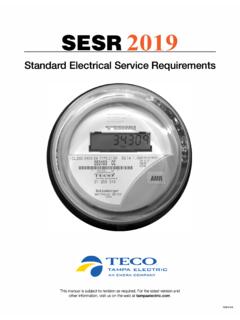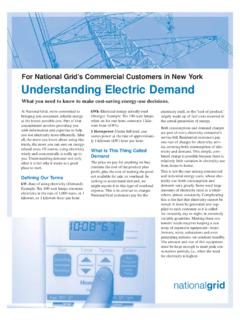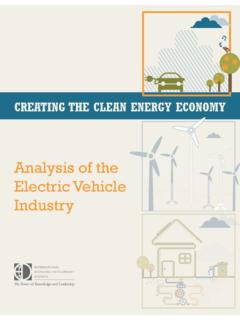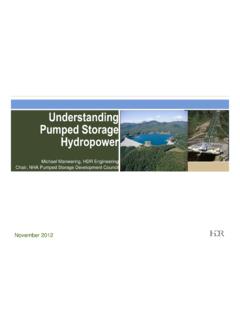Transcription of Understanding Solar Storage - Clean Energy Group
1 Answers to Commonly Asked Questions About Solar PV and Battery Storage Understanding Solar + Storage ++ Understanding Solar + Storage provides information and guidance to address some of the most commonly asked questions about pairing Solar photovoltaic systems with battery Storage technologies ( Solar + Storage ). Topics included in the guide range from factors to consider when designing a Solar + Storage system, battery sizing, safety and environmental considerations, and how to value Solar + Storage . The guide is organized into 12 topic area questions. These questions and the issues discussed within each section were informed by and developed for community-based organizations. The guide was produced under the Resilient Power Project ( ), a joint project of Clean Energy Group and Meridian Institute. The Resilient Power Project works to accelerate market development of resilient, Clean Energy solutions in low-income and underserved communities to further Clean Energy equity by ensuring that all communities have access to the economic, health, and resiliency benefits that Solar + Storage can provide.
2 The Resilient Power Project is supported by The JPB Foundation, The Kresge Foundation, Surdna Foundation, Nathan Cummings Foundation, The New York Community Trust, Barr Foundation, and Merck Family authors would like to thank Mayra Cruz at Catalyst Miami, Logan Atkinson Burke at Alliance for Affordable Energy , Shelley Robbins at Upstate Forever, Chelsea Barnes at Appalachian Voices, Timna Zemel and Chris Keast at Simpliphi Power, Will Heegard at Footprint Project, Geoff Oxnam at American Microgrid Solutions, and Meghan Monahan at Clean Energy Group for their valuable input and review of this guide. Maria Blais Costello of Clean Energy Group was rseponsible for report production, working with David Gerratt of DG Communications on the report design. Much appreciation also for the generous support of the foundations and organizations funding this work. The views and opinions expressed in this guide are solely those of the document is for informational purposes only.
3 The authors make no warranties, expressed or implied, and assume no legal liability or responsibility for the accuracy, completeness, or useful-ness of any information provided within this document. The views and opinions expressed herein do not necessarily state or reflect those of funders or any of the organizations and individuals that have offered comments as this document was being drafted. The authors alone are responsible for the contents of this report. Before acting on any information you should consider the appropri-ateness of the information to your specific situation. The information contained within is subject to change. It is intended to serve as guidance and should not be used as a substitute for a thorough analysis of facts and the law. The document is not intended to provide legal or technical report can be found on the Clean Energy Group website at this ReportMarriele Mango | Seth MullendoreCleAn Energy grouPOCTOBER 2020 Understanding Solar +StorageAnswers to Commonly Asked Questions About Solar PV and Battery Storage 5 Glossary of terms 8 Introduction12 Q1: What factors do I need to consider when designing a Solar + Storage system?
4 17 Q2: What different types of batteries are available (and which one is right for me)?21 Q3: What size battery do I need?26 Q4: Is Solar + Storage an effective backup power solution?31 Q5: Can Storage be added to an existing Solar system?35 Q6: How long does a Solar + Storage system last?38 Q7: How much do batteries cost?42 Q8: How do I determine the value of Solar + Storage (savings, revenue, resilience)?50 Q9: How can I pay for a Solar + Storage system (incentives, grants, financing)?55 Q10: Can Solar + Storage be developed to benefit low-income communities?60 Q11: Is battery Storage safe?63 Q12: What are the environmental impacts of battery Storage ?67 Conclusion68 About the Resilient Power Project69 About the authorsintroduction contentsTable of Contentsclean Energy Group | 5 | Understanding Solar +storageAVoided outAge CoStS: Avoided outage costs represent the value of losses that would have been incurred if a facility were to experience a power outage without a backup power system.
5 Losses could include decreased workforce productivity, interruption of services, and even loss of life due to a lack of medical care or disaster response services. BAttery Storage : Battery Storage is a rechargeable battery that stores Energy from other sources, such as Solar arrays or the electric grid, to be discharged and used at a later time. The reserved Energy can be used for many purposes, including shifting when Solar Energy is consumed onsite, powering homes or businesses in the event of an outage, and generating revenue for the system owner by providing grid services. Behind-the-meter: Behind-the-meter, also known as customer-sited, Energy Storage systems are located on the owner s property, literally behind the utility meter on the customer side, as opposed to front-of-the-meter, utility-side systems, which are located directly on the utility distribution Solar : Community Solar , also called shared Solar , is a purchasing arrangement in which multiple customers share the electricity or the economic benefits of Solar power from a single Solar array.
6 Community Solar installations may be physically located at a property shared by the customers, such as a multifamily apartment building, or located at a remote AnAlySiS: A cost-benefit analysis compares the costs and benefits of a particular investment with other investment options, and/or maintaining the status quo ( , not making an investment).CritiCAl loAdS: The electrical equipment and devices that are most important to maintain power to during a grid outage. Critical loads will vary depending on facility types and customer needs. Examples of common critical loads include emergency lighting, outlets for charging devices, and : Cycling is the process of a battery system charging (storing Energy ) and discharging (releasing Energy ). Essentially, one full charge and discharge represents one : Solar panels and battery Storage systems become less efficient as they operate over time. For Solar panels, the amount of Energy produced slowly declines due to the effects of exposure to the elements.
7 Battery Storage Energy capacity declines as batteries are charged and discharged due to chemical reactions that occur as part of the processes. The rate of these declines is the degradation mAnAgement: The ability to reduce grid electricity usage during times of high onsite glossaryGlossary of Terms Clean Energy Group | 6 | Understanding Solar +storagedemAnd reSPonSe: Lowering consumption of grid electricity, either through discharging stored Energy or lowering the use of devices, in response to utility signals. These demand response events typically occur at times when systemwide demand for grid electricity is high, such as hot days when air conditioning is consuming more Energy than ArBitrAge: The storing of Energy , either from the grid or onsite generation, during periods when electricity prices are low, to be discharged at a later time when electricity prices are higher. Energy CAPACity: The total amount of Energy that can be stored by an Energy Storage system, usually measured in kilowatt-hours, or megawatt-hours for larger Storage denSity: A measure of how much Energy (kilowatt-hours) can be stored in a battery per unit of weight, which typically corresponds to battery size.
8 Usually, a more Energy dense battery will require less physical space in an regulAtion: The balancing of electricity supply and demand to keep grid frequency within acceptable bounds for the electric power system to operate properly. grid: A network that delivers electricity from producers to consumers. Utilities typically operate the grid and charge customers for the Energy they SerViCeS: Services, such as frequency regulation, voltage support, and demand response, that support the operation, balance and management of the power SyStem: A system that includes both renewable Energy and fossil-fuel components. For example, a Solar + Storage system with a diesel : The process of connecting a distributed generation system, such as Solar PV and battery Storage , to the grid. Utilities will oftentimes mandate an interconnection review in order to ensure that the proposed system will have no negative impacts on the : An inverter is used to convert DC power generated by Solar and battery Storage into AC power for use in homes and businesses and/or AC power from the grid to DC when charging a battery Storage system.
9 KilowAtt: A kilowatt is a measure of power. One kilowatt is equal to 1,000 watts. kilowAtt-hour: A kilowatt-hour is a measure of how much Energy is used. A device requiring 1 kilowatt of power that is operated for two hours will use 2 kilowatt-hours of Energy . On a utility bill, a kilowatt-hour indicates how much Energy was delivered to a customer by an electric : A microgrid is a local Energy system with onsite sources of generation that can disconnect from the utility grid and operate independently. A microgrid may be composed of a single building, sometimes referred to as a nanogrid, or multiple interconnected Energy metering (nem): Net Energy metering programs allow customers to earn utility bill credits for the electricity they generate from their Solar array that is not directly consumed : Local Energy systems that operate completely separate and disconnected from the demand : The highest level of power demand (kilowatts) during a given ShAVing: The process of lowering peak demand by discharging stored Energy during times of high Energy glossaryclean Energy Group | 7 | Understanding Solar +storagePower PurChASe Agreement (PPA): A type of third-party financing that establishes an agreement between a developer and a customer to install a Solar (or Solar + Storage ) system on a customer s property with little to no out-of-pocket expenses.
10 Through the agreement, the customer pays the third-party an agreed upon rate (dollars per kilowatt-hour) for the Energy generated by the rAting: The maximum rate at which a battery can charge or discharge Energy . The power rating of a battery is typically given in kilowatts, or megawatts for larger battery : When a battery or other type of Energy management system is used to maximize the amount of Solar Energy directly consumed onsite and minimize the amount of Solar generation sent to the PAyBACk Period: The time it takes for a project s savings and revenue to equal or exceed the full installed cost of the + Storage : A Solar photovoltaics array connected to a battery Storage system through one or more Solar : A Solar system that was installed anticipating that battery Storage would be installed at a later date. Adding battery Storage to a Storage -ready Solar system is an easier and oftentimes less expensive process than adding battery Storage to a Solar system that did not plan for the addition of : The ability for a backup power system to maintain continuous power without relying on access to outside resources that may be experiencing Power: The ability to provide a facility with continuous, Clean , and reliable power even when the electric grid goes down.








